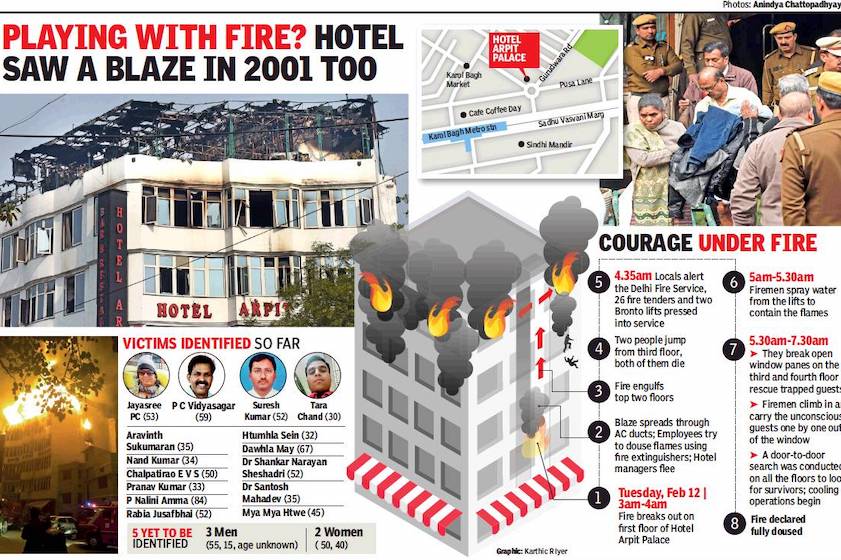Delhi: Fire safety, firefighting
This is a collection of articles archived for the excellence of their content. |
Contents |
Major incidents
1986-2019

From: Somreet Bhattacharya & Vibha Sharma, February 13, 2019: The Times of India

From: Somreet Bhattacharya & Vibha Sharma, February 13, 2019: The Times of India
See graphics:
Major fire incidents in Delhi, 1986-2019
Fire in Hotel Arpit Palace, Karol Bagh, Delhi; Location; Victims; Sequence of events
1986: Siddharth Hotel fire
The inferno at a central Delhi hotel on Tuesday revived the horrifying memory of another blaze at a south Delhi hotel in 1986 that had resulted in 38 deaths.
On January 23 that year, a little after 2am, staff at the nine-storey Siddharth Hotel (Vasant Continental today) had broken into frantic activity after fire had broken out at the banquet hall in the basement of the hotel. In no time, the fire had spread through the floors and engulfed the rooms, many of which had been occupied by foreigners and Indian businessmen.
A news report of the time had said that the occupants came from Japan, France, the Soviet Union, Australia and the United States apart from two diplomats from West Germany and Argentina who had died in their sleep. An Australian woman named Eva was also among the deceased.
The managing director of Rourkela Steel Plant, officials from Kirloskar company, and a Japanese executive working with Maruti were also among the deceased. Two girls from Bahrain were among the survivors, but their parents had been claimed by the blaze.
The victims had made desperate attempts to escape. They tried use bed linen as ropes to climb down, but failed as the knots loosened with their weight. But a few had managed to beat death by hiding inside filled-up bath tubs.
Though over 30 years apart, the Siddharth Hotel inferno and the Arpit hotel one have many similarities. In the 1986 fire, too, three people had died after jumping out of hotel windows. Identification of the guests in that fire had been hindered as the hotel’s guest registers had been gutted, just like in the Tuesday’s incident. Most victims were on business trips in both the fires, and most of the deaths were due to asphyxiation.
Just like in the case of Siddharth Hotel, rescue operation at Hotel Arpit Palace suffered a setback due to electricity failure due to which the fire-fighters had to grope in the dark. Those who had managed to wake up and tried to escape had to navigate through darkness. Even after that, many had not survived in 1986 as they couldn’t find the keys kept in glass cases to unlock the emergency exits.
Safety cushion nets were also missing.
In 2005, the accused—the security inspector, the lobby manager and hotel management—were acquitted. In 2013, the Delhi high court upheld the trial court verdict. Nevertheless, the Siddharth Hotel fire had brought to the fore inadequate safety measures in place in capital’s high-rises. But it seems nothing has changed on the ground 33 years later.